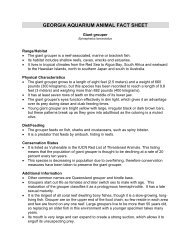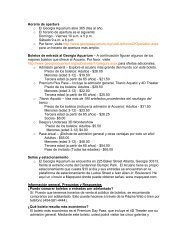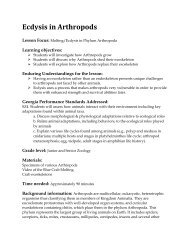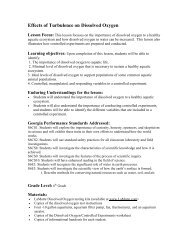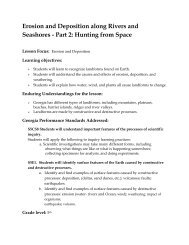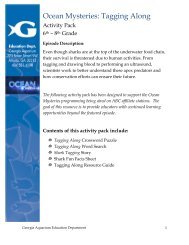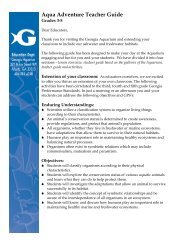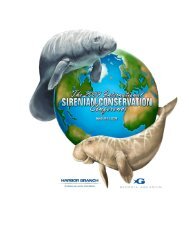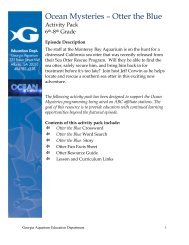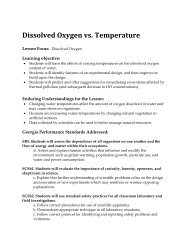Animal Behavior - Georgia Aquarium
Animal Behavior - Georgia Aquarium
Animal Behavior - Georgia Aquarium
Create successful ePaper yourself
Turn your PDF publications into a flip-book with our unique Google optimized e-Paper software.
Procedure:<br />
First Day (in class):<br />
1. Go over background information with the students. Discuss the importance of<br />
animal behavior research and the methods used in research.<br />
2. Explain ethograms and show the students an example of one. Ask the students<br />
how they think researchers develop ethograms.<br />
3. Explain to the students that they will be developing an ethogram of their own<br />
and using it to collect data on animal behavior.<br />
4. Pass out <strong>Animal</strong> Data Collection worksheets for students to take home.<br />
Homework (may be done over several days):<br />
1. Have each student choose an animal (a pet, a friend’s pet, an animal easily<br />
viewed in a backyard, park, or in your house), and observe the animal for 15<br />
minutes.<br />
2. During observation, students should take notes on the animal’s behaviors,<br />
beginning to separate and identify distinct behaviors.<br />
3. Using the data collected from these preliminary observations, students will<br />
create an ethogram by choosing 5 specific behaviors and making a list of these<br />
behaviors with a description of each one. Alternatively, students may use<br />
photographs or sketches to represent the behaviors.<br />
4. Once the students have developed their ethograms, they will fill in the names of<br />
the five behaviors in the spaces on their <strong>Animal</strong> Data Collection sheet.<br />
5. Students will use the worksheet to do 3 separate observations of their animal.<br />
Teacher may decide if these observations should be done at different times on<br />
the same day or at the same time for 3 consecutive days.<br />
6. Before each observation session, the student should record the date, time, and<br />
any environmental factors (weather if they are outside, noise, presence of other<br />
animals or people, etc.).<br />
7. During each observation session, the student will watch their animal for 5<br />
minutes, recording its behavior every ten seconds (they can count these out<br />
rather than using a timer). For example, once they start their five minute session,<br />
they will count to ten. On ten, whatever behavior the animal is performing is<br />
what they will mark down a tally for on their worksheet. They then start over<br />
counting to ten and repeat until their 5 minutes are up.<br />
8. Students may use the “additional observations” section on their worksheet to<br />
record any “other” or unusual behaviors or to make any notes.<br />
9. After finishing all three observation sessions, each student should write a few<br />
paragraphs explaining what conclusions they can draw from their observations,<br />
any difficulties they had, and anything they think merits further study.<br />
Last Day (in class):<br />
1. As a class, discuss the students’ data collection experiences. What difficulties did<br />
they have? Were there factors that affected the collection process? How do they<br />
think they could improve the study methods?<br />
2. Either split the students into groups to have them discuss their findings with<br />
each other, or have each student give a brief presentation of their conclusions.<br />
The <strong>Georgia</strong> <strong>Aquarium</strong> ~ Education Department 4



